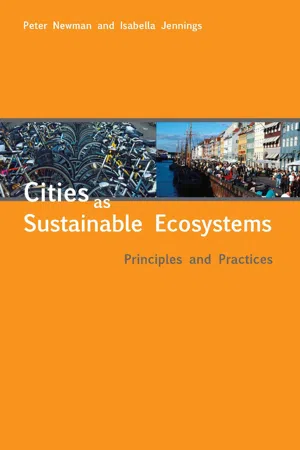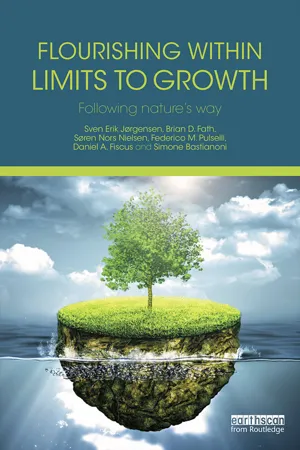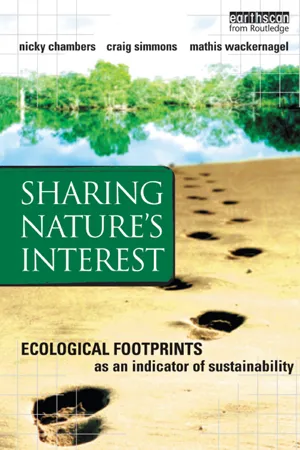Geography
Ecological Footprint
The ecological footprint measures the amount of biologically productive land and water required to support a person's lifestyle and consumption habits. It takes into account factors such as food consumption, energy use, and waste production. This concept helps to assess the impact of human activities on the environment and provides insight into sustainability and resource management.
Written by Perlego with AI-assistance
7 Key excerpts on "Ecological Footprint"
Learn about this page
Index pages curate the most relevant extracts from our library of academic textbooks. They’ve been created using an in-house natural language model (NLM), each adding context and meaning to key research topics.
- eBook - ePub
Cities as Sustainable Ecosystems
Principles and Practices
- Peter Newman, Isabella Jennings(Authors)
- 2012(Publication Date)
- Island Press(Publisher)
Our Ecological Footprint: Reducing Human Impact on the Earth , to provide an indication of the human load on the biosphere. Since then, the concept has attracted considerable interest, with many countries, cities, regions, and organizations undertaking Ecological Footprint analyses.Chambers, Simmons, and Wackernagel define Ecological Footprint as “the land and water area that is required to support indefinitely the material standard of living of a given human population, using prevailing technology” (2000, 17). The Global Development Research Center defines the Ecological Footprint of a city as “the amount of land required to sustain its metabolism; that is, to provide the raw materials on which it feeds, and process the waste products it excretes.”1 Visually, it could be conceived of as the area that a glass dome over the city would have to cover in order to maintain the population at their current standard of living. As Ecological Footprints are calculated on year-specific data, they provide a snapshot of current impacts. Thus they are likely to vary over time, with changes in technology and variations in material flows (Best Foot Forward 2002).To decide how sustainable a population is, human demand is compared with what is available—an area’s biocapacity. Biocapacity refers to the amount of “nature” or biologically productive resources available to supply human demand. Original estimates of global biocapacity by Wackernagel and Rees (1996) excluded areas of low biological productivity such as deserts, ice caps, and open ocean. The remaining area is adjusted for biodiversity protection purposes and then divided by the global population of that year to estimate a per capita supply figure, sometimes called the average “earthshare” (Best Foot Forward 2002). - eBook - ePub
Flourishing Within Limits to Growth
Following nature's way
- Sven Erik Jørgensen, Brian D. Fath, Søren Nors Nielsen, Federico M. Pulselli, Daniel A. Fiscus, Simone Bastianoni(Authors)
- 2015(Publication Date)
- Routledge(Publisher)
2 in the atmosphere are just a few noticeable examples. Environmental changes indicate that humanity is far from sustainable, as human demand is likely to be exceeding the regenerative and absorptive capacity of the biosphere. Moreover, several studies showed that many of Earth’s thresholds are being exceeded to the extent to which the biosphere’s future ability to provide for humanity is at risk (see Notes 5, 6, and 65). If continued, overshoot will permanently reduce the Earth’s ecological capacity and lead to ecological collapse and social misery. Careful management of human interaction with the biosphere is thus essential to ensure future prosperity; systemic accounting tools are needed for tracking the combined effects of the many pressures that humans are placing on the planet.The footprint methodology is based on six assumptions (see Notes 64 and 66 ):- It is possible to track the annual amounts of resources consumed and wastes generated by countries.
- The majority of these resource flows can be related to the bioproductive area necessary for their regeneration and the assimilation of their waste.
- By weighting each area in proportion to its usable biomass productivity (annual production of usable biomass), the different areas can be expressed in terms of a standardized average productive hectare. They are called “global hectares.”
- The overall demand can be aggregated by adding all mutually exclusive resource-providing and waste-assimilating areas.
- The aggregate Ecological Footprint and biocapacity can be directly compared to each other.
- Area demanded can exceed area supply.
The Ecological Footprint accounts for the appropriation of biocapacity across six distinct land use types (namely: cropland, grazing land, forest land, fishing grounds, built-up land, and carbon uptake land). These land types represent the area requested for the production of crop food and other fiber products (cropland), meat and other animal products (grazing land), timber and others forest products (forest land), fish products (fishing grounds), and shelter and other infrastructures (built-up land); the carbon uptake land represents the area requested to neutralize the CO2 (the only waste the methodology takes into account) and is calculated as the forest area needed to absorb the anthropogenic carbon dioxide emissions. The Ecological Footprint also relates to six demand categories (namely food and fibers, housing, transport, goods and services, and waste). The final Ecological Footprint of an individual or a country is the sum of all these different types of land, irrespective of where they are located (for details about the calculations, see Note 41 ). Average productivity differs between the land use types. As such, for comparability across them, Ecological Footprint and biocapacity are usually expressed in global hectares (gha; see Note 41 - (Author)
- 2014(Publication Date)
- Woodhead Publishing(Publisher)
The yield factor forms a useful comparison of the national average yield per hectare to the world average yield in the same land category. The equivalence factor defines the relative productivity among the land and sea area types.5.2.1 Ecological Footprint accounting of products and processes
By means of the depletion or use of resources, generation and assimilation and the utilization of services from nature, every individual, process, product, action and region impacts our living planet. These impacts must be accounted for and should be converted to biologically productive areas. The Ecological Footprint (EF) accounts for the human appropriation of ecological production in area units and expresses the exploitation of natural resources by human activities in a single dimension of land and water demanded to support them.6The Ecological Footprint can be calculated for an individual, a village, a locality, a nation or the whole world itself, along with organizations, services, products and processes.7 Similar to other indicators discussed in previous chapters, the Ecological Footprint can be calculated for different products by following a life cycle approach, and can also be calculated for various processes to produce a particular product.The Ecological Footprint (EF) of a product can be measured for cradle to gate or cradle to grave stages or at any stage associated with the life cycle assessment (LCA) of that product. By mapping the entire life cycle phases associated with the chosen product, one can quantify its EF through consideration of three parameters:- eBook - ePub
Sharing Nature's Interest
Ecological Footprints as an Indicator of Sustainability
- Nicky Chambers, Craig Simmons, Mathis Wackernagel(Authors)
- 2014(Publication Date)
- Routledge(Publisher)
2 accumulation, interact. The authors have dubbed this the ‘small bed-cover effect’. When one has a cold head at night the tendency is to pull the bed-cover over one’s face. But then the feet start to stick out and get chilly. Similarly, once the footprint gets bigger than the ecological capacity, human uses compete against each other for ecological space. Alleviating the pressure on one ecosystem merely shifts the strain to another. For example, the increase in fish farming to overcome the depletion of the ocean fish stocks in turn requires more sea space for low grade fish and arable land for feed production. Or, worse, one impact may start to exacerbate another one. For example, deforestation decreases an area’s humidity and therefore the productivity of surrounding ecosystems.QUESTION 2 – ISN’T THE FOOTPRINT JUST ANOTHER ARBITRARY SUSTAINABILITY INDEX ?Far from it. The Ecological Footprint is based on the measurement of nature’s interest – the resources that nature can renewably generate and the pollution that it can cope with. EFA recognizes the finite capacity of the planet and gives a clear indication of the amount of nature that we have and how much we are currently using. The footprint is also consistent with basic laws of thermodynamics (see Annexe 1 : A Primer on Thermodynamics).QUESTION 3 – ISN’T THE FOOTPRINT A BIT TOO SIMPLISTIC ?For sure, it would be ideal to model the total complexities of the world’s ecological systems, but this is not possible and not necessary for most purposes. The Ecological Footprint is certainly one of the simpler models that describe human use of nature but one which serves a well defined purpose. Essentially, the Ecological Footprint is a planning tool to help people understand and deal more effectively with ecological limits. To be an effective planning tool, it is not necessary to have a sophisticated model of how nature works, but rather one which is easy to grasp. In this respect it acts as a ‘least common denominator’ model of nature’s function.QUESTION 4 – WHAT’S THE ADVANTAGE OF SIMPLIFYING SO MUCH ?Such a model encourages a more productive communication between opposing world views. In the authors’ experience the simple premises behind the Ecological Footprint are accepted by a wide variety of people and thus provide a good common starting point for debate. It speaks to those who believe in human dependence on nature and the necessity to preserve ecological capacities to secure human survival. It also resonates with those who believe that economic activities are the origin of wealth and that only continued economic growth can ensure social peace. In other words, the footprint is a communal gathering point to encourage a diversity of people on a shared journey. Also, although the concept and representation of the footprint is essentially simplistic, the method and calculations used to derive those footprints can be as detailed as the data and human endeavour allow it to be. - eBook - ePub
The Rise and Rise of Indicators
Their History and Geography
- Stephen Morse(Author)
- 2019(Publication Date)
- Routledge(Publisher)
4Ecological FootprintIntroduction
The notion of a ‘footprint’ representing an impact is probably as old as the human race. It has been said that one of the most popular poems ever written in English is Henry Wadsworth Longfellow’s ‘A Psalm of Life’ and in it we find the words:Lives of great men all remind us We can make our lives sublime, And, departing, leave behind us Footprints on the sands of time.Over thousands of years we have, as a species, certainly had a big impact on the planet upon which we live, and that impact continues to this day. We can actually see many of those impacts from orbit including the effects of infrastructure and agriculture, while others may be less obvious. Carbon dioxide and many other ‘greenhouse’ gases are colourless and can’t be seen with the naked eye, and while some pollution of our water systems can be seen from space, there are others that cannot. At the time of writing this book there are increasing concerns about plastic pollution in the oceans, and, while it is possible to see the accumulations of such waste on the surface, this material does degrade over time; however the chemicals and particles that are released can be highly damaging to ocean life. All this represents humanity’s visible and invisible footprint on the planet.The use of the footprint analogy has found its way into the world of indicators, and we see it today in two forms – the ‘Ecological Footprint’ and the ‘carbon footprint’. They sound similar, but are in fact quite different. The Ecological Footprint is designed to encapsulate humanity’s broad impact on the planet in terms of the resources that we use to live and to support our quality of life, and is expressed in terms of the surface area of the planet needed to support an individual based on what they produce and consume. By way of contrast, the carbon footprint is a measure of the release of greenhouse gases (e.g. carbon dioxide and methane) associated with a product or process. The carbon footprint is expressed in terms of carbon dioxide equivalents (or CO2 - Subramanian Senthilkannan Muthu(Author)
- 2020(Publication Date)
- Woodhead Publishing(Publisher)
The yield factor forms a useful comparison of the national average yield per hectare to the world average yield in the same land category. The equivalence factor defines the relative productivity among the land and sea area types.5.2.1. Ecological Footprint accounting of products and processes
By means of the depletion or use of resources, generation and assimilation and the utilization of services from nature, every individual, process, product, action and region impacts our living planet. These impacts must be accounted for and should be converted to biologically productive areas. The EF accounts for the human appropriation of ecological production in area units and expresses the exploitation of natural resources by human activities in a single dimension of land and water demanded to support them.6The EF can be calculated for an individual, a village, a locality, a nation or the whole world itself, along with organizations, services, products and processes.7Similar to other indicators discussed in previous chapters, EF can be calculated for different products by following a life cycle approach and can also be calculated for various processes to produce a particular product.The EF of a product can be measured for cradle to gate or cradle to grave stages or at any stage associated with the life cycle assessment (LCA) of that product. By mapping the entire life cycle phases associated with the chosen product, one can quantify its EF through consideration of three parameters:- 1. The amount of area required for the production of crops, forest and animal products relating to that product.
- 2. The area needed to sequester atmospheric carbon dioxide emissions, principally related to the combustion processes of fossil fuels used in the generation of the product.
-
3. The area required for producing the nuclear energy for the generation of the product.8 –10
From an LCA perspective, the EF of a product can be defined as the sum of the time-integrated direct and indirect land occupation, where the latter is related to nuclear energy use and to CO2 emissions from fossil fuel use. It is calculated as10,11- eBook - ePub
Everyday Lifestyles and Sustainability
The Environmental Impact Of Doing The Same Things Differently
- Fabricio Chicca, Brenda Vale, Robert Vale, Fabricio Chicca, Brenda Vale, Robert Vale(Authors)
- 2018(Publication Date)
- Routledge(Publisher)
2 . A hectare of New Zealand’s productive pastureland has a very different productivity to a hectare in Antarctica. The comparison between a hectare from Antarctica and one in New Zealand would be environmentally meaningless. To deal with this, the Global Footprint Network (GFN), based on the concept devised by Wackernagel and Rees (1996), uses the notion of a “global hectare”, which is a hectare of land with the global average productivity. The concept of global hectare is based on the concept of biocapacity. The GFN defines Ecological Footprint (EF) and biocapacity as follows:On the demand side, the Ecological Footprint measures a country’s use of cropland, forests, grazing land, and fishing grounds for providing resources and absorbing carbon dioxide from burning fossil fuels. On the supply side, biocapacity measures how much biologically productive area is available to regenerate these resources and services.(Global Footprint Network, 2017)The global hectare allows researchers to account for the available biocapacity and the demand on biocapacity (the EF), which we all make by our demands for goods and services. The total biocapacity for a whole country can be obtained by multiplying the biocapacity value published by the GFN in global hectares per person by the total population of the country. Although we have used the concept and some data from the GFN, our calculations for the specific impact follow a similar but slightly different methodology. Knowing the total biocapacity for each country has allowed us to calculate a “country index” for converting hectares of land in a given country into global hectares by dividing the total biocapacity in global hectares by the area of the country in “normal” hectares. Using the biocapacity for a particular country takes into account a number of factors, including the amount of land taken up by buildings and infrastructure, the capacity to generate energy or to sequester carbon dioxide, and how fertile the soil is.






